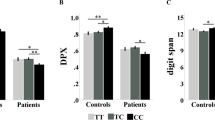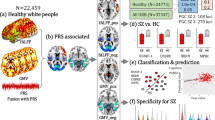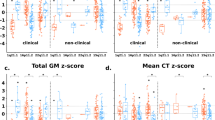Abstract
The single-nucleotide polymorphism (SNP) rs1344706 in ZNF804A is one of the best-supported risk variants for psychosis. We hypothesized that this SNP contributes to the development of schizophrenia by affecting the ability to understand other people’s mental states. This skill, commonly referred to as Theory of Mind (ToM), has consistently been found to be impaired in schizophrenia. Using functional magnetic resonance imaging, we previously showed that in healthy individuals rs1344706 impacted on activity and connectivity of key areas of the ToM network, including the dorsomedial prefrontal cortex, temporo-parietal junction, and the posterior cingulate cortex, which show aberrant activity in schizophrenia patients, too. We aimed to replicate these results in an independent sample of 188 healthy German volunteers. In order to assess the reliability of brain activity elicited by the ToM task, 25 participants performed the task twice with an interval of 14 days showing excellent accordance in recruitment of key ToM areas. Confirming our previous results, we observed decreasing activity of the left temporo-parietal junction, dorsomedial prefrontal cortex, and the posterior cingulate cortex with increasing number of risk alleles during ToM. Complementing our replication sample with the discovery sample, analyzed in a previous report (total N=297), further revealed negative genotype effects in the left dorsomedial prefrontal cortex as well as in the temporal and parietal regions. In addition, as shown previously, rs1344706 risk allele dose positively predicted increased frontal–temporo-parietal connectivity. These findings confirm the effects of the psychosis risk variant in ZNF804A on the dysfunction of the ToM network.
Similar content being viewed by others
Log in or create a free account to read this content
Gain free access to this article, as well as selected content from this journal and more on nature.com
or
References
Abu-Akel A, Shamay-Tsoory S (2011). Neuroanatomical and neurochemical bases of theory of mind. Neuropsychologia 49: 2971–2984.
Bennett CM, Miller MB (2010). How reliable are the results from functional magnetic resonance imaging? Ann NY Acad Sci 1191: 133–155.
Bora E, Yucel M, Pantelis C (2009). Theory of mind impairment in schizophrenia: meta-analysis. Schizophr Res 109: 1–9.
Brunet-Gouet E, Decety J (2006). Social brain dysfunctions in schizophrenia: a review of neuroimaging studies. Psychiatry Res 148: 75–92.
Brüne M (2005). ‘Theory of mind’ in schizophrenia: a review of the literature. Schizophr Bull 31: 21–42.
Carrington SJ, Bailey AJ (2009). Are there theory of mind regions in the brain? A review of the neuroimaging literature. Hum Brain Mapp 30: 2313–2335.
Couture SM, Penn DL, Roberts DL (2006). The functional significance of social cognition in schizophrenia: a review. Schizophr Bull 32 (Suppl 1): S44–S63.
Das P, Lagopoulos J, Coulston CM, Henderson AF, Malhi GS (2012). Mentalizing impairment in schizophrenia: a functional MRI study. Schizophr Res 134: 158–164.
Decety J, Grèzes J, Costes N, Perani D, Jeannerod M, Procyk E et al (1997). Brain activity during observation of actions. Influence of action content and subject’s strategy. Brain 120: 1763–1777.
Decety J, Sommerville JA (2003). Shared representations between self and other: a social cognitive neuroscience view. Trends Cogn Sci 7: 527–533.
Esslinger C, Kirsch P, Haddad L, Mier D, Sauer C, Erk S et al (2011). Cognitive state and connectivity effects of the genome-wide significant psychosis variant in ZNF804A. Neuroimage 54: 2514–2523.
Esslinger C, Walter H, Kirsch P, Erk S, Schnell K, Arnold C et al (2009). Neural mechanisms of a genome-wide supported psychosis variant. Science 324: 605.
Farrow TFD, Zheng Y, Wilkinson ID, Spence SA, Deakin JFW, Tarrier N et al (2001). Investigating the functional anatomy of empathy and forgiveness. Neuroreport 12: 2433–2438.
Friedman L, Glover GH (2006). Report on a multicenter fMRI quality assurance protocol. J Magn Reson Imaging 23: 827–839.
Frith CD, Frith U (1999). Interacting minds—a biological basis. Science 286: 1692–1695.
Girgenti MJ, Loturco JJ, Maher BJ (2012). ZNF804a regulates expression of the schizophrenia-associated genes PRSS16, COMT, PDE4B, and DRD2. PloS One 7: e32404.
Hargreaves A, Morris DW, Rose E, Fahey C, Moore S, Cummings E et al (2012). ZNF804A and social cognition in patients with schizophrenia and healthy controls. Mol Psychiatry 17: 118–119.
Hill MJ, Bray NJ (2012). Evidence that schizophrenia risk variation in the ZNF804A gene exerts its effects during fetal brain development. Am J Psychiatry 169: 1301–1308.
Hill MJ, Jeffries AR, Dobson RJB, Price J, Bray NJ (2011). Knockdown of the psychosis susceptibility gene ZNF804A alters expression of genes involved in cell adhesion. Hum Mol Genet 44: 1–27.
Johnson MB, Kawasawa YI, Mason CE, Krsnik Ž, Coppola G, Bogdanović D et al (2009). Functional and evolutionary insights into human brain development through global transcriptome analysis. Neuron 62: 494–509.
Johnson SC, Baxter LC, Wilder LS, Pipe JG, Heiserman JE, Prigatano GP (2002). Neural correlates of self-reflection. Brain 125: 1808–1814.
Knafo A, Zahn-Waxler C, Hulle C, Van, Robinson JL, Rhee SH (2008). The developmental origins of a disposition toward empathy: genetic and environmental contributions. Emotion 8: 737–752.
Lee K-H, Brown WH, Egleston PN, Green RDJ, Farrow TFD, Hunter MD et al (2006). A functional magnetic resonance imaging study of social cognition in schizophrenia during an acute episode and after recovery. Am J Psychiatry 163: 1926–1933.
Lee TMC, Liu H-L, Tan L-H, Chan CCH, Mahankali S, Feng C-M et al (2002). Lie detection by functional magnetic resonance imaging. Hum Brain Mapp 15: 157–164.
Maldjian JA, Laurienti PJ, Kraft RA, Burdette JH (2003). An automated method for neuroanatomic and cytoarchitectonic atlas-based interrogation of fMRI data sets. Neuroimage 19: 1233–1239.
Meyer-Lindenberg A, Nicodemus KK, Egan MF, Callicott JH, Mattay V, Weinberger DR (2008). False positives in imaging genetics. Neuroimage 40: 655–661.
Meyer-Lindenberg A, Olsen RK, Kohn PD, Brown T, Egan MF, Weinberger DR et al (2005). Regionally specific disturbance of dorsolateral prefrontal-hippocampal functional connectivity in schizophrenia. Arch Gen Psychiatry 62: 379–386.
Meyer-Lindenberg A, Weinberger DR (2006). Intermediate phenotypes and genetic mechanisms of psychiatric disorders. Nat Rev Neurosci 7: 818–827.
O’Donovan MC, Craddock N, Norton N, Williams H, Peirce T, Moskvina V et al (2008). Identification of loci associated with schizophrenia by genome-wide association and follow-up. Nat Genet 40: 1053–1055.
Park IH, Ku J, Lee H, Kim SY, Kim SI, Yoon KJ et al (2011). Disrupted theory of mind network processing in response to idea of reference evocation in schizophrenia. Acta Psychiatr Scand 123: 43–54.
Park K-M, Kim J-J, Ku J, Kim SY, Lee HR, Kim SI et al (2009). Neural basis of attributional style in schizophrenia. Neurosci Lett 459: 35–40.
Paulus FM, Krach S, Bedenbender J, Pyka M, Sommer J, Krug A et al (2011). Partial support for ZNF804A genotype-dependent alterations in prefrontal connectivity. Hum Brain Mapp 27: 118–119.
Rasetti R, Sambataro F, Chen Q, Callicott JH, Mattay VS, Weinberger DR (2011). Altered cortical network dynamics: a potential intermediate phenotype for schizophrenia and association with ZNF804A. Arch Gen Psychiatry 68: 1207–1217.
Riley B, Thiselton D, Maher BS, Bigdeli T, Wormley B, Mcmichael GO et al (2010). Replication of association between schizophrenia and ZNF804A in the Irish case – control study of schizophrenia sample. Mol Psychiatry 15: 29–37.
Rizzolatti G, Fabbri-Destro M (2008). The mirror system and its role in social cognition. Curr Opin Neurobiol 18: 179–184.
Rose EJ, Donohoe G (2013). Brain vs behavior: an effect size comparison of neuroimaging and cognitive studies of genetic risk for schizophrenia. Schizophr Bull 39: 518–526.
Saxe R, Powell LJ (2006). It’s the thought that counts: specific brain regions for one component of theory of mind. Psychol Sci 17: 692–699.
Schnell K, Bluschke S, Konradt B, Walter H (2011). Functional relations of empathy and mentalizing: an fMRI study on the neural basis of cognitive empathy. Neuroimage 54: 1743–1754.
Schnell K, Heekeren K, Daumann J, Schnell T, Schnitker R, Möller-Hartmann W et al (2008). Correlation of passivity symptoms and dysfunctional visuomotor action monitoring in psychosis. Brain 131: 2783–2797.
Shrout PE, Fleiss JL (1979). Intraclass correlations: uses in assessing rater reliability. Psychol Bull 86: 420–428.
Shulman GL, Astafiev SV, Franke D, Pope DLW, Snyder AZ, McAvoy MP et al (2009). Interaction of stimulus-driven reorienting and expectation in ventral and dorsal frontoparietal and basal ganglia-cortical networks. J Neurosci 29: 4392–4407.
Sprong M, Schothorst P, Vos E, Hox J, Van Engeland H (2007). Theory of mind in schizophrenia: meta-analysis. Br J Psychiatry 191: 5–13.
Sugranyes G, Kyriakopoulos M, Corrigall R, Taylor E, Frangou S (2011). Autism spectrum disorders and schizophrenia: meta-analysis of the neural correlates of social cognition. PLoS One 6: e25322.
Van Den Bossche MJA, Docx L, Morrens M, Cammaerts S, Strazisar M, Bervoets C et al (2012). Less cognitive and neurological deficits in schizophrenia patients carrying risk variant in ZNF804A. Neuropsychobiology 66: 158–166.
Van Overwalle F (2009). Social cognition and the brain: a meta-analysis. Hum Brain Mapp 30: 829–858.
Van Overwalle F, Baetens K (2009). Understanding others’ actions and goals by mirror and mentalizing systems: a meta-analysis. Neuroimage 48: 564–584.
Walter H (2012). Social cognitive neuroscience of empathy—concepts, circuits and genes. Emotion Rev 4: 9–17.
Walter H, Ciaramidaro A, Adenzato M, Vasic N, Ardito RB, Erk S et al (2009). Dysfunction of the social brain in schizophrenia is modulated by intention type: an fMRI study. Soc Cogn Affect Neurosci 4: 166–176.
Walter H, Schnell K, Erk S, Arnold C, Kirsch P, Esslinger C et al (2011). Effects of a genome-wide supported psychosis risk variant on neural activation during a theory-of-mind task. Mol Psychiatry 16: 462–470.
Walters JTR, Corvin A, Owen MJ, Williams H, Dragovic M, Quinn EM et al (2010). Psychosis susceptibility gene ZNF804A and cognitive performance in schizophrenia. Arch Gen Psychiatry 67: 692–700.
Williams HJ, Norton N, Dwyer S, Moskvina V, Nikolov I, Carroll L et al (2011). Fine mapping of ZNF804A and genome-wide significant evidence for its involvement in schizophrenia and bipolar disorder. Mol Psychiatry 16: 429–441.
Wittchen H-U, Wunderlich U, Gruschwitz S, Zaudig M (1997) SKID-I. Strukturiertes Klinisches Interview für DSM-IV. Hogrefe: Göttingen.
Zhang R, Yan J-D, Valenzuela RK, Lu S-M, Du X-Y, Zhong B et al (2012). Further evidence for the association of genetic variants of ZNF804A with schizophrenia and a meta-analysis for genome-wide significance variant rs1344706. Schizophr Res 141: 40–47.
Acknowledgements
We thank Josephine Klaembt, Phöbe Schmierer, Carola Opitz von Boberfeld, Beate Newport, and Dagmar Gass for help with data acquisition and Torsten Wüstenberg for technical support.
Author information
Authors and Affiliations
Corresponding author
Additional information
Supplementary Information accompanies the paper on the Neuropsychopharmacology website
Supplementary information
PowerPoint slides
Rights and permissions
About this article
Cite this article
Mohnke, S., Erk, S., Schnell, K. et al. Further Evidence for the Impact of a Genome-Wide-Supported Psychosis Risk Variant in ZNF804A on the Theory of Mind Network. Neuropsychopharmacol 39, 1196–1205 (2014). https://doi.org/10.1038/npp.2013.321
Received:
Revised:
Accepted:
Published:
Issue date:
DOI: https://doi.org/10.1038/npp.2013.321
Keywords
This article is cited by
-
Theory of mind, emotion recognition, delusions and the quality of the therapeutic relationship in patients with psychosis – a secondary analysis of a randomized-controlled therapy trial
BMC Psychiatry (2020)
-
Hyperfunctioning of the right posterior superior temporal sulcus in response to neutral facial expressions presents an endophenotype of schizophrenia
Neuropsychopharmacology (2020)
-
A systematic review of associations between functional MRI activity and polygenic risk for schizophrenia and bipolar disorder
Brain Imaging and Behavior (2019)
-
Control of CNS Functions by RNA-Binding Proteins in Neurological Diseases
Current Pharmacology Reports (2018)
-
The schizophrenia risk gene ZNF804A: clinical associations, biological mechanisms and neuronal functions
Molecular Psychiatry (2017)



